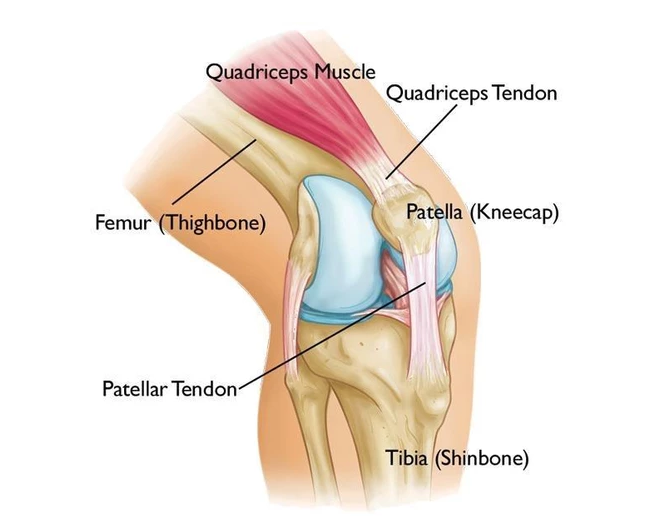Pain that strikes at the front of the knee is known as Anterior Knee Pain and can be caused by various specific conditions such as:
Patellofemoral (Knee joint – kneecap) Pain Syndrome.
Chondromalacia Patellae (softening of the cartilage on the back of the kneecap).
Osgood-Schlatter’s disease (Quadriceps tendon anchoring issue – see our related blog).
Sinding Larsen Johansson Syndrome (Inflammation of where the Quadriceps tendon passes over the far-front part of the kneecap).
Plica Synovialis Syndrome (Enlargement via inflammation of the front Knee Joint capsule).
Knee Bursitis (inflammation of a small fluid-filled sac (bursa) situated near the front of the knee joint.
Hoffa’s Disease (or fat pad syndrome – pain in the front of the knee occurs due to problems with the far kneecap situated natural fat pad).
Articular Cartilage Injury (wear & tear or accidental damage to the joint surface).
Osteochondritis Dissecans (painful self-limiting developmental derangement of normal bone growth mostly within the growth plate areas near the joint)
Patellofemoral instability/Subluxation (Knee & Kneecap alignment instability – risk of abnormal positioning/movement)
Patellar (Kneecap) Stress Fracture(s)
Patellar Tendinopathy (structural/chemical changes to the Quadriceps tendon)
Patellofemoral (knee joint – Kneecap) Osteoarthritis
Pes Anserine Bursitis (a specifically combined tendon insertion derangement)
Iliotibial Band Syndrome (A large wide tendon position along the outside of the thigh which insertions onto the front/outside of the Knee joint).
As well as the conditions already stated, there can also be common underlying issues; muscular imbalance/weakness leading to patella malalignment on movements of the knee; flexion and extension, this can be brought on by overuse injuries (so-called RSI’s).
There is no clear definition of anterior knee pain, due to the large variety of conditions causing the same symptoms on the anterior aspect of the knee, location of pain, and tolerated pain levels by an individual.

Common Signs and Symptoms of Anterior Knee Pain:
Crepitus (cracking/grinding) located at the front of the knee.
Instability; walking in general, walking up / down-stairs, walking on uneven surfaces.
Pain gets worse on daily activities such as; walking down-stairs, sitting for prolonged periods of time, pressing on the pedals when driving.
General muscle weakness.
Who is commonly affected by anterior knee pain?
Teenagers and younger adults.
High impact sport participants (runners, jumpers, footballers, skiers, etc.).
Previous injury to the knee/kneecap.
Obesity.
Those with chronic conditions such as Osteoarthritis.
What Should I Do If I Have Knee Pain?
If you are struggling with knee pain especially around the anterior aspect (front and central knee) and have signs and symptoms as mentioned it is best to get the knee checked out by a qualified healthcare / medical practitioner.
When you first see a qualified practitioner, they will begin with a verbal assessment collecting your past medical history, and talk through your current complaint. Once your practitioner has discussed your past medical history and got a good understanding of your current complaint, they will start the hands-on assessment looking at:
General observation; looking at your natural biomechanics, looking at the alignment of the entire lower extremity, Angle, alignment & leg length
Palpation of the painful location
Knee function; general knee flexion and extension, stepping up and downstairs, squats, jumps, etc.
Ligament structure
Muscle structure; hypertrophy of the muscles, imbalance within muscles, muscle tightness
Muscular strength; quadriceps muscle group, hamstrings muscle group, calf muscle group, gluteal muscle group
Specific tests for the nature of the injury
Neurological Assessment; looking at dermatomes, reflexes, balance, and/or proprioceptive
Joints above and below the affected area
Your practitioner will ask you questions from the KUJALA Scoring Questionnaire to help gauge the severity of your anterior knee pain
Knee Pain Treatment:
Strengthening weaker muscles; improving eccentric muscular control, closed chain exercises, increasing vastus medialis obliquus (VMO), etc.
Loosening off tighter muscles to help increase muscular length; massage, stretching, etc.
Supporting biomechanics; Taping, shoe inserts, etc. to complement traditional therapies above
Passive treatments such as Electrotherapy, ultra-sound, or ESWT (Extra-Corporeal Shockwave Therapy)
Your clinician/practitioner may also ask you to rest or decrease your exercise load.
